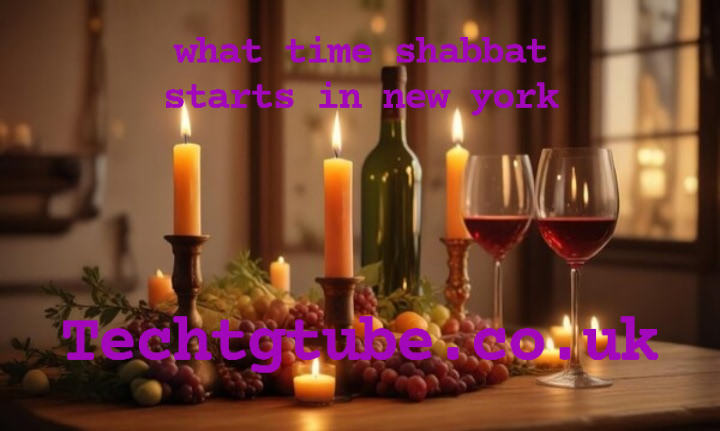Introduction
Shabbat, also known as the Jewish Sabbath, holds profound spiritual, cultural, and historical significance in Judaism. It is a weekly day of rest, reflection, and spiritual rejuvenation that begins at sunset on Friday evening and concludes at nightfall on Saturday. For observant Jews around the world, Shabbat is a time to disconnect from the chaos of daily life and reconnect with their faith, family, and community. In New York, a city bustling with diversity and energy, Shabbat observance takes on a unique character, as countless synagogues, families, and communities prepare to welcome this sacred time. Understanding what time Shabbat starts in New York is essential for proper observance, as the timing is based on specific halachic (Jewish legal) principles tied to sunset. This article delves deeply into the intricacies of Shabbat timing, its significance, and how it is observed in the vibrant Jewish community of New York.
The Importance of Shabbat Timing
The precise timing of Shabbat is a cornerstone of its observance. According to Jewish law, Shabbat begins 18 minutes before sunset on Friday and ends when three stars become visible in the night sky on Saturday. These times are not arbitrary but rooted in halachic tradition and astronomical calculations. In New York, where the sunset time varies throughout the year, accurately determining what time Shabbat starts requires consulting a Jewish calendar or a reliable source that provides candle-lighting times specific to the city. The 18-minute window before sunset serves as a safeguard, ensuring that individuals do not inadvertently start Shabbat late, which could lead to the violation of its sanctity.
Factors Affecting Shabbat Timing in New York
One of the fascinating aspects of Shabbat timing in New York is the city’s geographical location. Positioned at a latitude that experiences significant variations in daylight hours between summer and winter, New York sees Shabbat begin as early as 4:10 PM in December and as late as 8:11 PM in June. These shifts require careful planning for those who observe Shabbat, especially in winter when the early start time can impact work schedules and daily routines. Additionally, weather conditions such as overcast skies or atmospheric haze may obscure the visibility of stars, affecting the traditional method of determining Shabbat’s conclusion. Modern technology, however, has mitigated these challenges, with online tools and apps providing precise Shabbat start and end times for New York.
The Role of Synagogues in Shabbat Preparation
Synagogues play a central role in preparing the Jewish community for Shabbat in New York. From the iconic synagogues of Manhattan, such as the Spanish and Portuguese Synagogue and Congregation Emanu-El, to the smaller shuls in Brooklyn’s Borough Park and Williamsburg, each congregation fosters a sense of unity and spiritual readiness. These synagogues often distribute weekly bulletins containing Shabbat start times, Torah portions, and inspirational messages. The Friday evening Kabbalat Shabbat service marks the official commencement of Shabbat, filling the sanctuary with melodies, prayers, and a palpable sense of sanctity. For many, this communal gathering is an integral part of their Shabbat experience, emphasizing the importance of punctuality and awareness of when Shabbat begins.
Personal Preparation for Shabbat
In addition to communal efforts, personal preparation is essential for observing Shabbat. Families across New York engage in a range of activities to ready their homes and hearts for this sacred time. The lighting of Shabbat candles, traditionally performed by women, is a poignant ritual that signifies the start of Shabbat. The act of lighting candles is accompanied by a blessing, invoking peace and holiness within the home. This practice must be completed before the designated Shabbat start time, underscoring the importance of timing. Furthermore, preparations such as cooking meals, setting the table, and ensuring that electronic devices are turned off or set to Sabbath mode must be completed before sunset, reflecting the day’s focus on rest and spirituality.
Shabbat Observance in New York’s Diverse Jewish Community
New York’s Jewish community is incredibly diverse, encompassing Orthodox, Conservative, Reform, and other denominations, each with its unique approach to Shabbat observance. For Orthodox Jews, strict adherence to halachic rules regarding work, travel, and technology defines their Shabbat experience. They rely heavily on the precise determination of when Shabbat starts and ends, as any deviation could compromise their observance. Conservative and Reform Jews, while more flexible in their practices, also place significant emphasis on the spiritual essence of Shabbat. Across the city, from the Upper West Side to Crown Heights, the streets take on a quieter tone as the Jewish community embraces the sanctity of Shabbat, demonstrating the unifying power of this ancient tradition.
Challenges and Solutions in Shabbat Timing
Living in a fast-paced city like New York presents challenges for observing Shabbat, particularly regarding timing. The early winter sunsets often conflict with work commitments, while summer’s extended daylight hours can make it difficult to transition into a restful mindset. To address these issues, many Jewish organizations and communities provide resources such as Shabbat-friendly transportation services, pre-prepared meals, and communal candle-lighting events. Moreover, technological advancements have made it easier than ever to stay informed about Shabbat start times, with apps and websites offering notifications and reminders tailored to New York’s time zone. These solutions reflect the adaptability and resilience of the Jewish community in upholding their traditions.
Conclusion
Understanding what time Shabbat starts in New York is more than a matter of punctuality; it is an expression of faith, commitment, and reverence for a sacred tradition. The timing of Shabbat, rooted in millennia-old halachic principles, serves as a reminder of the divine rhythm of creation and the importance of rest in our lives. For New York’s Jewish community, Shabbat is a weekly opportunity to step away from the demands of urban life and reconnect with their spiritual core. Despite the challenges posed by the city’s dynamic nature, the observance of Shabbat remains a testament to the enduring power of faith and tradition. As individuals and families light their Shabbat candles and gather around their tables, they affirm the timeless relevance of this cherished day of rest.
FAQs
1. What determines the start time of Shabbat in New York? Shabbat starts 18 minutes before sunset, based on halachic calculations specific to New York’s geographical location and time of year.
2. How can I find accurate Shabbat start times for New York? You can consult a Jewish calendar, visit community websites, or use apps designed to provide precise Shabbat times for your location.
3. Why is there an 18-minute window before sunset? The 18-minute window acts as a buffer to ensure that Shabbat begins on time and to avoid any potential violations of its sanctity.
4. What are some tips for preparing for Shabbat in New York? Plan ahead by checking the Shabbat start time, preparing meals and household tasks in advance, and setting aside time for personal reflection and prayer.
5. How does New York’s Jewish community adapt to varying Shabbat times? The community offers resources such as reminders, communal events, and Shabbat-friendly services to accommodate the unique challenges posed by New York’s dynamic environment.
Your article has been completed with an engaging introduction, detailed content with clear headings, a comprehensive conclusion, and a relevant FAQ section. Let me know if there are any additional changes you’d like to make!
Also Read This: What Time Does Shabbat Start in New York? A Comprehensive Guide









